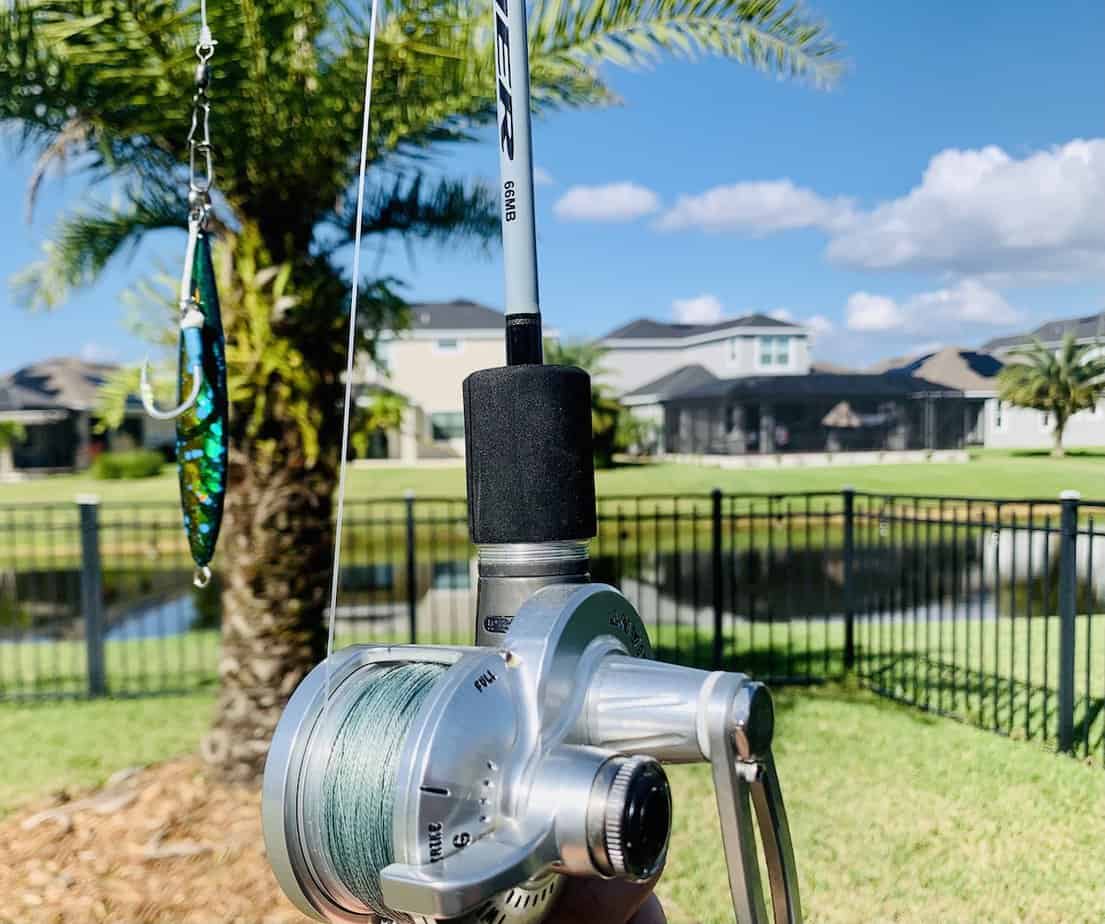The author generated this text in part with GPT-3, OpenAI’s large-scale language-generation model. Upon generating draft language, the author reviewed, edited, and revised the language to their own liking and takes ultimate responsibility for the content of this publication.
What is a Slow Pitch Jig and How Does it Work?
A slow pitch jig is a type of fishing lure, typically of leaf or teardrop shape, designed to flutter as it falls to the ocean floor. The lure mimics a dying baitfish during the fall and slow-moving prey on the retrieve. It is most often struck during the fall. The jig itself turns horizontally and wobbles during freefall, and then turns vertical and usually darts on the retrieve. The angler must know how to give the jig enough slack to turn horizontally at the peak of each rhythm.
The design of a slow pitch jig can vary. Some have a slim profile and longer length, while some have a wide profile and shorter length. Some jigs are designed to fall horizontally with center-weight, while others spiral and are rear-weighted. Some have two symmetric sides, while others are not symmetric. Having a variety of slow jigs on hand is helpful so you can change them out based on the conditions or when the fish aren’t biting.
Although most other lures have weights listed in ounces, slow jig weights are normally listed in grams. The lure rating range on slow pitch jigging rods is also normally listed in grams. It may seem odd when you first start getting into slow pitch jigging, but it makes it quite easy to estimate what size lure to use. For every 100 ft of water, your lure should be 100 grams. So if you’re in 150 grams of water, choose a 150g lure. You can go heavier if the current is strong, or choose the closest size you have if you don’t have the exact size for your depth.
You may notice after looking at jigs, that the smallest slow pitch jigs you can typically find are about 80 grams and the largest are about 500 grams. This reflects the most common water depths for slow pitch jigging. Shallow slow pitch jigging is done around 80-150 ft of water, while deeper slow pitch jigging goes up to 500 ft of water.
Slow pitch jigs are most commonly used to target bottom species such as flounder, grouper, and snapper, although they can also be used to target pelagics as long as the angler is maintaining the jig around the middle of the water column.
How Do You Do A Slow Pitch Jigging Technique?
Slow jigs are used with a slow pitch jigging technique. In this technique, the lure falls to the ocean floor while the reel is in a controlled freespool. The lure turns horizontally and wobbles or flutters as it falls. These jigs are often struck on the fall, opposite of most other fishing techniques. The jig’s action mimics that of a dying baitfish, so fish tend to strike softly.
Slow pitch jigging is used to target bottom fish like grouper and snapper. These species are found near underwater structure such as reef, ledges, humps, and rocks. A slow pitch jig is typically rigged with a monofilament leader which provides abrasion resistance around these rough structures. Generally a 15-30 ft monofilament leader is long enough. Fluorocarbon can also be used, when you’re not dealing with rough structure.
To work the jig, you let it fall in a controlled freespool all the way to the ocean floor. The jig is meant to fall somewhat slowly as it wobbles and flutters all the way down. Once the jig hits the bottom, the angler puts thumb pressure on the spool, pulls up the rod tip and gently points the rod tip back down. The whole method is slow and rhythmic.
Your choice of jig should change depending on the conditions. When the currents are strong, you’ll notice a wide jig will fall too slowly and be taken by the current. In slow pitch jigging, the jig must fall as close to straight down as possible for the best action. For this reason, a narrower jig works better when currents are strong. Wide jigs are great for light currents. You’ll want to have a variety of jigs on hand because it’s tough to predict currents before a day out on the water.
Most of your strikes will occur as the jig is falling down, so you’ll find the most success if you maximize the time your lure spends in a fall. Anglers will usually get better at this over time. The jigs are also painted with flashy colors and patterns to attract fish from further away by reflecting light.
This technique relies heavily on a specialized rod. My article Slow Pitch Jigging Rods talks about the best slow pitch jigging rods out there. You’ll also need to fight the fish with the right type of reel. My article Slow Pitch Jigging Reels covers all you need to know about slow jigging reels.
What Kind of Hooks are on Slow Pitch Jigs?
These jigs are rigged with specially designed assist hooks meant to hook into fish with minimal tension on the line. Since the jigs are struck while in freespool, a well-designed hook can be the difference between a caught fish and one that go away.
Assist hooks are made with extremely sharp tips to penetrate more easily. When the jig is struck during freefall, the weight of the jig is enough for a hookset. The assist hook cords are heavy duty with a fluorocarbon core and braid layer on the exterior. This combination keeps the cord stiff enough to avoid tangling with additional assist hooks, and prevents degradation from UV light and water.
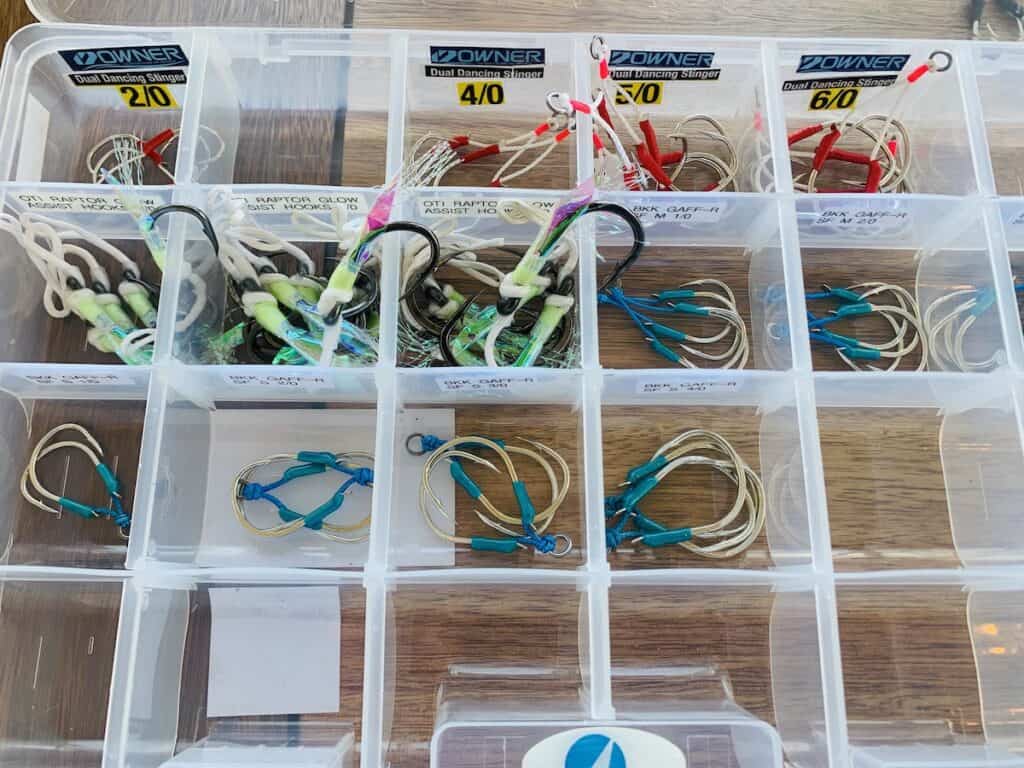
It’s possible for fish to get away if the hook doesn’t penetrate, or if the hook bends. Some twin assist hooks are made with light wire and light cord which could be ripped off if you get a fish with only one hook. Multiple hooks on the jig improves the likelihood of landing the fish by giving you multiple penetration spots. You’ll often see slow pitch jigs rigged with up to 4 hooks. The extra hooks will get them anywhere from the sides of the face, to the gill plates.
Assist hooks vary from single hooks to twin hooks and thin cord to thick cord. Some assist hooks have extra material for flash, while others don’t. Choosing the right hooks for your jig can be tricky and I’ll explain in the next section of the article.
How Do You Rig A Slow Pitch Jig?
Rigging a slow pitch jig can be done in numerous ways. The number of assist hooks ranges from 1 to 4, although be sure to check your local regulations because California has a limit of 2 hooks on a jig. In this section of the article, I’ll share some common rigging options and key tips.
Option 1: Rigging with 1 Hook
To rig with only one hook, you can choose whether to put a single hook on the top eyelet or the bottom eyelet. The Nomad Buffalo jig comes pre-rigged with one hook on the bottom eyelet and the Nomad Gypsea jig comes pre-rigged with one hook at the top eyelet. Both options will work, so feel free to experiment with placing to see if you notice a difference in hookups.
When a single hook is used, it’s much more critical that the hook is a heavy gauge wire to avoid the possibility of hook bending. Rigging with a single hook is most beneficial when jigging in deep water. Excess hooks cause extra drag which can substantially slow down a jig falling 500 ft to the ocean floor.
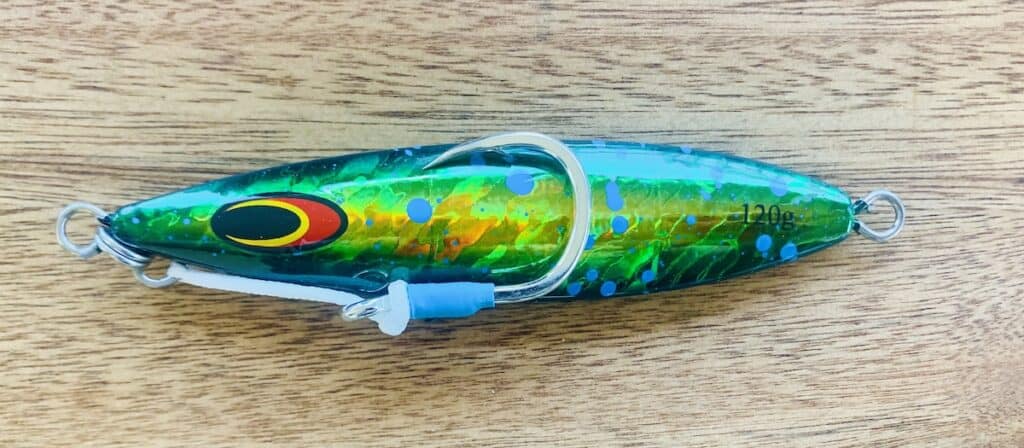
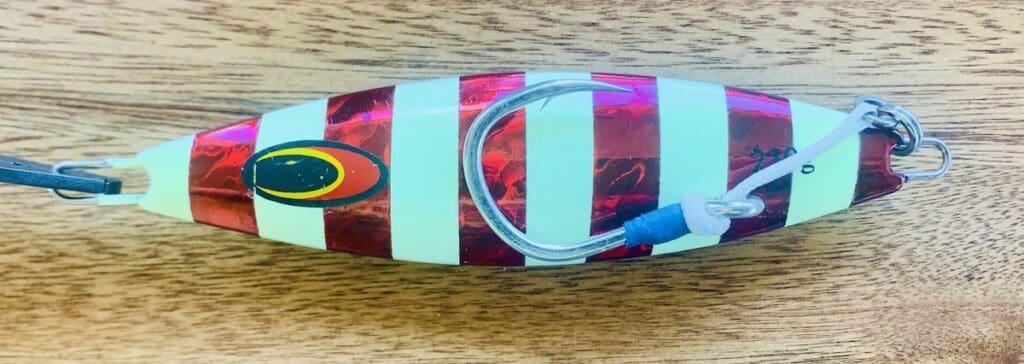
Option #2: Rigging with 2 Hooks
Some assist hooks come with added materials for flash. When looking at the picture below, you can see how it could get heavy and busy if I were to add two more hooks with flash on the bottom eyelet of the jig. I’ve seen some anglers rig with 4 hooks with flash and have no issues, but if you do it, I would be aware that too much may have a negative effect.
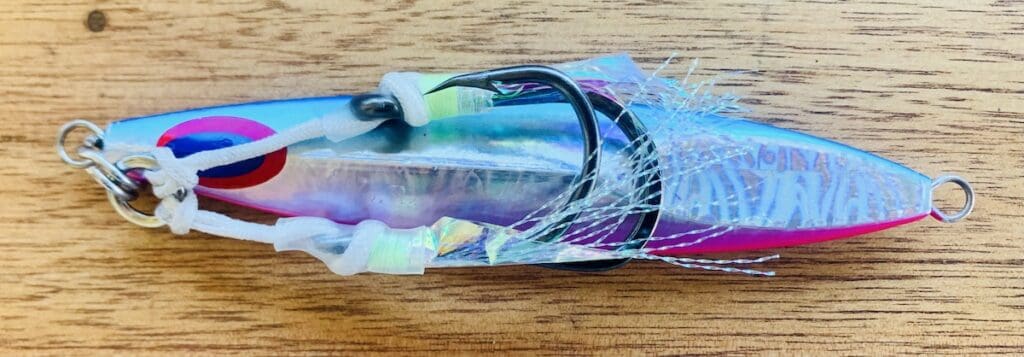
OTI Slow Pitch Jig size 155g color blue/pink comes pre-rigged with a single size 8/0 OTI flash assist hook and size 8 split ring. I added 1 more 8/0 flash assist hook.
Option 3: Rigging with 4 Hooks
Some jigs don’t come with any hooks at all. For example, the JYG 100g Blue Deep Slow Pitch Jig comes unrigged. In the images below, you can see how the jig comes unrigged, and then the second picture shows the jig rigged with twin size 2/0 owner dual dancing stinger assist hooks. The width of the hooks looks good in comparison to the jig but it doesn’t quite reach the midpoint of the jig. This is a long jig so it’s hard to find hooks with cords this long. To avoid a short strike, I would add two more size 2/0 owner dual dancing stinger hooks to the bottom of the jig, as shown in the last picture. Alternatively, you could rig your own assist hooks and make a cord long enough.

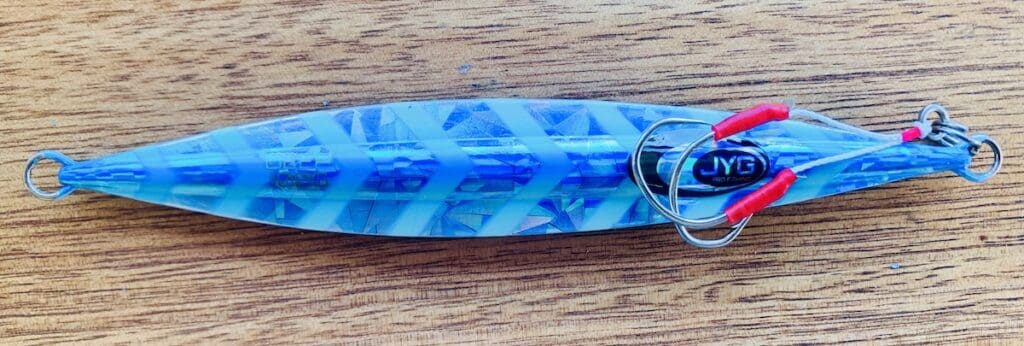
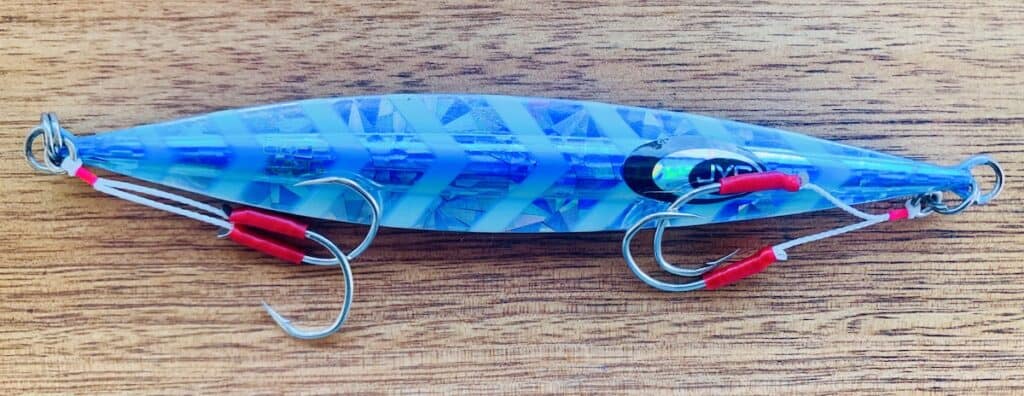
On shorter jigs, the hooks will fall closer to each other, like they do on this one. This Shimano Butterfly Flat Fall jig, size 100g, color Zebra Glow. This one comes pre-rigged with 2 hooks on the bottom eyelet, and I added a size 5 Owner Hyperwire split ring, size 1/0 BKK GAFF-R Short assist hooks and a size 4 SPRO Power Swivel. Note, I ran out of ball bearing swivels so I’ll have to change this out for a ball bearing swivel once I get some new ones in the mail.
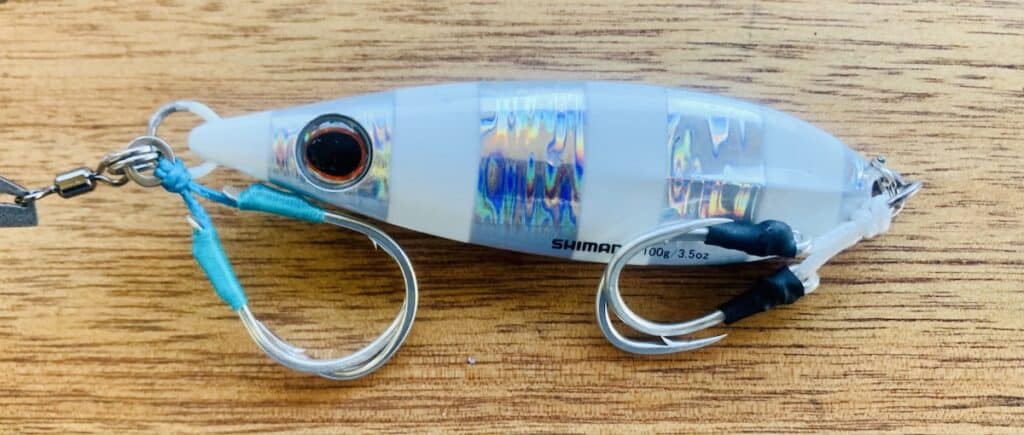
Key Tips for Rigging a Slow Pitch Jig
- The hook should be slightly narrower than the jig
Hook sizes are important and can be difficult to estimate when buying online. When using a single hook, the hook should be slightly less wide than the body of the jig and the bottom of the hook should hit about midway down the jig. See the two photos above for reference.
- A ball bearing swivel between the leader line and split ring allows the jig to move freely
No need to worry about line twist if the jig spirals or twists. When using a swivel with a split ring, make sure the attachment point of the swivel is big enough to move freely along the split ring. In lieu of a swivel, an additional solid ring between the split ring and leader can also improve the movability of the jig.
- For jigs rigged with 4 assist hooks, wrap half the jig in plastic wrap before storing in a jig bag with mesh pockets.
Storing a jig with 4 assist hooks attached can be hard. My jig bags have mesh pockets that make it really hard to slide jigs down if there are hooks on both eyelets. You could wait to add the second pair of assist hooks until right before use, or wrap the bottom half of the rigged jig in plastic wrap before putting in your jig bag. I like to use the Nomad Jig Wallet for jig storage.
- Buy at least two sizes of split ring pliers
Split ring pliers are meant for a certain range of split ring sizes. Depending on how broad your collection of jig sizes is, you may need different sized split ring pliers. I like the Shimano Power Pliers the best.
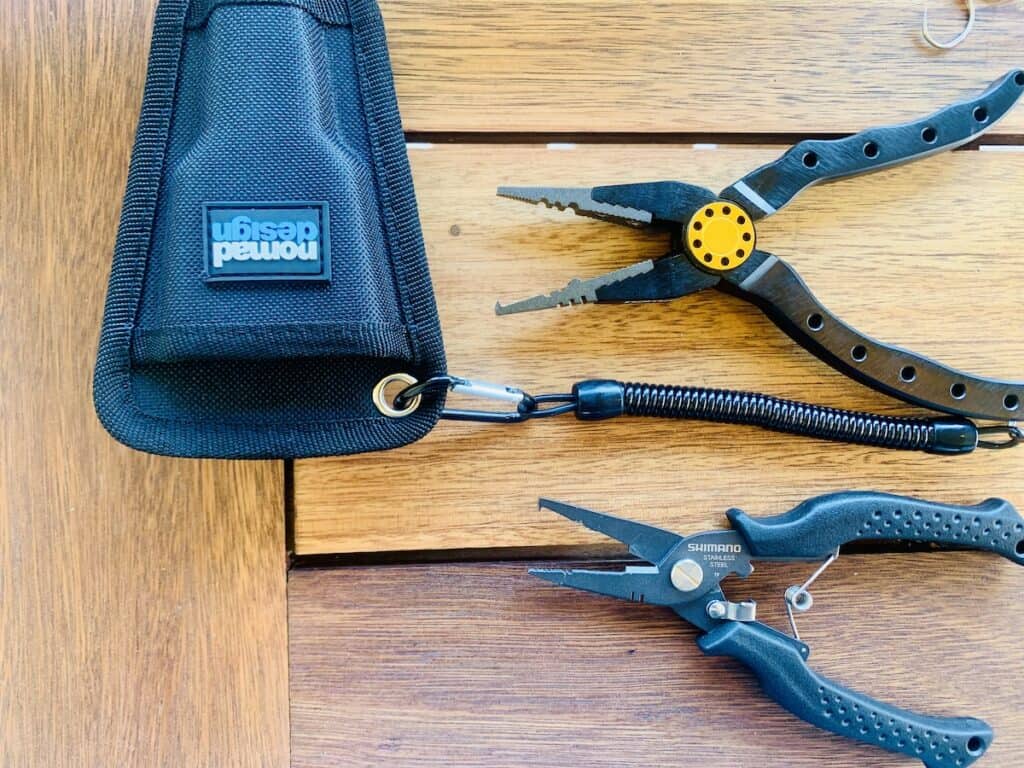
How to Attach The Leader to the Jig
When it comes to attaching the leader, you’ll want to avoid tying the line directly to the split ring. A split ring can damage the line and can also bend open. Instead, you’ll want to tie the leader to a ball bearing swivel which is attached to the split ring. To learn about jigging leader line length, strength, and material, read my article Jigging Leaders: Why You Need One and How to Use It.
Hope this article was helpful! Tight lines, y’all!

